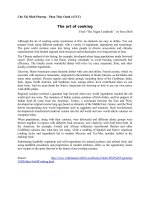The spirit of kaizen
Bạn đang xem bản rút gọn của tài liệu. Xem và tải ngay bản đầy đủ của tài liệu tại đây (792.71 KB, 133 trang )
Tai Lieu Chat Luong
Copyright © 2013 by Robert Maurer. All rights reserved. Except as
permitted under the United States Copyright Act of 1976, no part of this
publicationmaybereproducedordistributedinanyformorbyanymeans,
or stored in a database or retrieval system, without the prior written
permissionofthepublisher.
ISBN:978-0-07-179618-7
MHID:0-07-179618-5
The material in this eBook also appears in the print version of this title:
ISBN:978-0-07-179617-0,MHID:0-07-179617-7.
Alltrademarksaretrademarksoftheirrespectiveowners.Ratherthanputa
trademark symbol after every occurrence of a trademarked name, we use
names in an editorial fashion only, and to the benefit of the trademark
owner, with no intention of infringement of the trademark. Where such
designationsappearinthisbook,theyhavebeenprintedwithinitialcaps.
McGraw-Hill eBooks are available at special quantity discounts to use as
premiumsandsalespromotions,orforuseincorporatetrainingprograms.
Tocontactarepresentativepleasee-mailusat
This publication is designed to provide accurate and authoritative
information in regard to the subject matter covered. It is sold with the
understanding that neither the author nor the publisher is engaged in
renderinglegal,accounting,orotherprofessionalservice.Iflegaladviceor
otherexpertassistanceisrequired,theservicesofacompetentprofessional
personshouldbesought.
—FromaDeclarationofPrinciplesJointlyAdoptedbyaCommitteeofthe
AmericanBarAssociationandaCommitteeofPublishersandAssociations
TERMSOFUSE
This is a copyrighted work and The McGraw-Hill Companies, Inc.
(“McGraw-Hill”)anditslicensorsreserveallrightsinandtothework.Use
of this work is subject to these terms. Except as permitted under the
Copyright Act of 1976 and the right to store and retrieve one copy of the
work, you may not decompile, disassemble, reverse engineer, reproduce,
modify, create derivative works based upon, transmit, distribute,
disseminate, sell, publish or sublicense the work or any part of it without
McGraw-Hill’s prior consent. You may use the work for your own
noncommercial and personal use; any other use of the work is strictly
prohibited. Your right to use the work may be terminated if you fail to
complywiththeseterms.
THE WORK IS PROVIDED “AS IS.” McGRAW-HILL AND ITS
LICENSORS MAKE NO GUARANTEES OR WARRANTIES AS TO
THE ACCURACY, ADEQUACY OR COMPLETENESS OF OR
RESULTS TO BE OBTAINED FROM USING THE WORK,
INCLUDING ANY INFORMATION THAT CAN BE ACCESSED
THROUGH THE WORK VIA HYPERLINK OR OTHERWISE, AND
EXPRESSLY DISCLAIM ANY WARRANTY, EXPRESS OR IMPLIED,
INCLUDING BUT NOT LIMITED TO IMPLIED WARRANTIES OF
MERCHANTABILITY OR FITNESS FOR A PARTICULAR PURPOSE.
McGraw-Hill and its licensors do not warrant or guarantee that the
functions contained in the work will meet your requirements or that its
operation will be uninterrupted or error free. Neither McGraw-Hill nor its
licensorsshallbeliabletoyouoranyoneelseforanyinaccuracy,erroror
omission, regardless of cause, in the work or for any damages resulting
therefrom. McGraw-Hill has no responsibility for the content of any
information accessed through the work. Under no circumstances shall
McGraw-Hill and/or its licensors be liable for any indirect, incidental,
special,punitive,consequentialorsimilardamagesthatresultfromtheuse
oforinabilitytousethework,evenifanyofthemhasbeenadvisedofthe
possibility of such damages. This limitation of liability shall apply to any
claimorcausewhatsoeverwhethersuchclaimorcausearisesincontract,
tortorotherwise.
ForBenandJohnSikorra,
thebravestmenIhaveeverknown,
andfortheiramazingparents,
LoriandJoe
CONTENTS
ACKNOWLEDGMENTS
CHAPTERONE
ASwiftIntroductiontoKaizen
CHAPTERTWO
BoostMorale
CHAPTERTHREE
CutCosts
CHAPTERFOUR
ImproveQuality
CHAPTERFIVE
DevelopNewProductsandServices
CHAPTERSIX
IncreaseSales
CHAPTERSEVEN
ReduceHealth-CareExpenses
CHAPTEREIGHT
WhenSmallStepsAreTooHard:WhattoDo
APPENDIX
ReflectionsonKaizen
NOTES
INDEX
ACKNOWLEDGMENTS
Thisbookistheworkofmany
people,andIamgratefultohavethe
opportunitytosharetheirwisdomand
talentswithyou.LeighAnnHirschman,
mycowriter,putlyricsandmelodyto
thesekaizenconcepts.JenniferGriffin,
myagent,providedencouragement
andenthusiasmfortheproject.
Myfather,MortMaurer,demonstrated
thepowerofkaizenandthe
importanceofcreativitythroughhis
lifetimeofexperienceandsuccess
inmanybusinessenterprises.Knox
Huston,senioreditoratMcGraw-Hill,
guidedthisbooktopublication.My
friendSteveAlbert’shumorandlove
havealwayskeptmefromtaking
myselftooseriously.
Finally,I’dliketooffermuch
appreciationformyfamily:Dia,Larry,
andDru.Thankyouforsharingmy
passionforthisproject.
ChapterOne
ASWIFTINTRODUCTIONTOKAIZEN
Businessculturelovestheideaof
revolutionary,immediatechange.
Butturnaroundeffortsoftenfail
becauseradicalchangesetsoff
ourbrain’sfearresponseandshuts
downourpowerstothinkclearly
andcreatively.Amoreeffective
pathtochangebeginswiththe
smallstepsofkaizen.Thesequiet
stepsbypassourmentalalarmsystem,
allowingourcreativeandintellectual
processestoflowwithout
obstruction.Theresult:Changethat
isbothlastingandpowerful.
Leaders are often called upon to make significant improvements to their
organizations—to cut costs, to create new products, to reduce mistakes, to
improveservice,andsoon.Itispossibletomaketheseimprovementsbygritting
your teeth, squaring your shoulders, and forging ahead no matter what the
obstacles.
Possible, but not likely. Some managers enjoy this kind of bareknuckled
attack on their organization’s problems, and a few even succeed at it. Their
stories are dramatic (“I led our team through a complete reorganization in six
months!”)andfeatureadmirabledetermination(“Iwaspooranduneducated,but
Ididn’tletanythingstandinmyway;nowI’mtheheadofmyownmultibilliondollar business!”), so they are the ones that draw our attention. If you absorb
enoughofthesestories,youcaneasilygettheimpressionthattheonlywayto
reachyourmanagementgoalsistohurtleyourselfatthem,tearingdownthefast
tracktosuccessatbreakneckspeedandobliteratingallbarriersinyourpath.You
canalsodrawtheconclusionthatifyouhaven’treachedyourgoals,thereason
mustbethatyou’relackinginskillorgoodold-fashionedgrit.
Notso.Mostofusareprogrammedtoresistradicalchange.Letmesaythat
again:Wearebuilttoresistradicalchange.Asyou’llseeinthecomingpages,
our nervous system wires us for resistance to a big overhaul of any kind. This
truthappliesnotjusttomanagersbutalsototheemployeesweneedtocarryout
ourprogramsforchange.Soifyou’vetriedtochangeyourorganizationandmet
withdisappointment,thereisnoreasontofeelguilty.
But there is reason to feel optimistic. Most groups can achieve success
when theystep offthefasttrackandtakean alternativepath.Thispath issoft
underfoot and shaded overhead. It’s such an unassuming little byway that it
doesn’t attract the world’s notice, but believe me, some of the most successful
peopleandorganizationshavebeenusingitfordecadeswithconsistentlygood
results.Thispathstartswiththesmallestofsteps.Itcausesnostress,nofear…
andyoucantakeitallthewaytoyourgoal.
But before I tell you more about kaizen, I’d like you to meet some
strugglingbusinessowners.
“WENEEDSOMETHINGBOLDANDINNOVATIVE!”
At the time this story began, I was a clinical professor at the University of
California,LosAngeles(UCLA)SchoolofMedicine;Ispecializedinteaching
behavioralhealth.Itwasnotlongpastgraduation,andmanyofourstudentshad
been hired by existing physician groups or had banded together to start large
groupsoftheirown.Fourofthedoctors,however,haddecidedtocreateasmall
private practice devoted to family medicine. They were deliberate about this
decision.Theywantedtogivetheirpatientsthoughtful,personalcare,andthey
worriedthattheirfreedomtopracticeastheywishedwouldbestifledbyjoining
abiggergroup.
When the practice opened, I called to congratulate the young doctors on
their new business. However, the voices on the other end of the conversation
sounded far from celebratory. They were in trouble, they explained. They’d
committedtoaleaseonabeautifulofficeinaprimeSantaMonicalocationand
hadtakenonheavydebttopayforstate-of-the-artequipment.Inaddition,each
doctorhadhisorherownstudentdebtstopayoff.Alloftheseobligationswould
havebeenmanageable,theysaid,withasteadyflowofpatients.Butthepatients
weren’t coming. Their city, Santa Monica, had more than its share of doctors,
andmyformerstudentswererealizingthattheyhadenteredaverycompetitive
business world, one that their medical training hadn’t prepared them for.
Although they were bright, focused, and creative, they were also terrified of
losingeverything.
Sensing their distress, business consultants were knocking on the practice
door, offering them assistance and assurances of future prosperity—at a steep
price.Thedoctorsweretryingtofigureoutwheretogetthemoneytohireone
oftheseconsultants,ormaybeapublic-relationsexpert.Onephysicianpartner,
withstraincrackinghervoice,wasarguingtotakeonmoredebt.“Ifwewantto
win big,” she insisted, “we have to play big. We need something bold and
innovativetodrivepatientstoourdoors.”Yetshe,liketheothers,wasunableto
comeupwithaspecificideathatmightwork.
Isympathized.Theseweregood,caringdoctorswhocouldbringexcellent
caretotheircommunity.Iwantedthemtofeelhopefulandcreativeagain.But
theonethingIdidn’twantthemtodowastotrytoinnovatetheirwayoutofthe
problem.
INNOVATIONWORKS,EXCEPTWHENITDOESN’T
Whynot?What’swrongwithinnovation?
First,here’sadefinition.Sometimesthewordinnovationisusedtoreferto
anewideaoracleversolution,butinthisbookI’lladheretothemeaningthat’s
taught in business schools. There, innovation means change, but not just any
kind of change; innovation is a dramatic, sweeping change, one that’s usually
undertaken in a short amount of time. Innovation can be a clearly positive,
exciting change, such as the Apple computer’s marriage of scientific function
andelegantdesign.Orinnovationcanbeamuchmoredifficultchange,likean
austerityprogramthatlaysoffthousandsofworkers.
Otherexamplesofinnovationinclude:
•Changingthefocusofyourorganization.
•Adaptinganever-before-usedtechnology.
•Hiringallnewdepartmentheads.
•Declaringbankruptcy.
•Mergingwithanothercompany.
•Transformingthecompany’simage.
Wheninnovationgoeswell,theresultisnewproducts,creativesolutionsto
old problems, and vigorous organizations. And it’s fast! If you know you can
youachieveagoalquickly,whywaitaminutelongerthanyouhaveto?
The problem isn’t with innovation itself. It’s with our single-minded
approachtoinnovation.Whenwebelievethatradicalchange—thefasttrack—is
the only path to survival, growth, and ingenuity, we lose some of our
effectiveness.Ifwethinkthatwrenchingchangeisthesolesolutiontoproblems,
well…wetendtoletthoseproblemsgoforalongtime.Amajoroverhaulcan
feeltoohard,toopainful,andtootime-consumingtomanage,especiallywhen
we have so many other things to do. And so the problem grows. When the
problemistoobigtoignore,wefinallydecidetodosomethingaboutit…and
charge fiercely toward a solution. We say, “Let’s turn this culture around!” Or
“We’regoingtodotheimpossiblearoundhere!”Ifwesucceed,that’sterrific.
Butwhenchangetearsthroughanorganization,managersandstaffmaynot
feel as invigorated as you’d like them to. They often freeze up or feel
overwhelmed. That’s a big problem because radical change usually involves
radical risk: a huge investment of money, time, people, or goodwill. When
radical change fails, it can take down an entire department or even a whole
organization.Thedifficultyofsustaininganinnovativeapproachtochangeisthe
story of NASA in the 1990s, and of Ford and Xerox at the turn of the
millennium; these are all examples of organizations that tried innovation and
wereleftweakenedandontheirknees.Youcanprobablythinkofexamplesfrom
your own experience: breakneck deadlines that resulted in sloppy, slappedtogether products, morale initiatives that caused skepticism and scorn, and
demandsforcreativitythatledtostalled-outgroupthink.
That’swhyIdidn’twantthefamily-medicinegrouptoturntoinnovation.
They were already feeling scared and overwhelmed. With their emotional
resourcesdepleted,theywereinaweakpositiontocarryoutanykindofradical
change.Theyalsolackedthemoneytorevamptheirpractice.Ihatedtoseethem
digdeeperintodebtwithsuchunsureresults.
KaizenandInnovation:TwoStrategiesforChange
Whenyouneedtomakeachange,therearetwobasicstrategiesyoucanuse:
innovation and kaizen. Innovation calls for a radical, immediate rethink of the
statusquo.Kaizen,ontheotherhand,asksfornothingotherthansmall,doable
stepstowardimprovement.
Fortunately innovation is not the only way to create change. There’s an
alternative,onethatitissosimpleandpainlessthatpeopletendtodismissit.Yet
thismethodisextremelyeffective,whetheryouwanttomakeasmalladjustment
toyourstaffortransformtheglobe.Andallyouhavetodoistakeonesmall—
verysmall—stepatatime.
KAIZEN:GOODCHANGE
I’m talking, of course, about kaizen. Kaizen is a term from the Japanese
language. It’s a wonderfully perfect word that literally means “good change.”
The Asian origins of the word are a little bit misleading, though, because you
can easily get the impression that kaizen is at its core a uniquely Japanese
philosophy,onethatmightbedifficulttotranslateintoWesternculture.Actually,
kaizenwasbornintheUnitedStatesduringWorldWarII,atimethatdrewout
the very best qualities in Americans—our imagination, our bravery, and our
willingnesstoworkshoulder-to-shouldertogetthejobdone.
When France fell to Nazi Germany in 1940, the American government
realizedthatitwouldneedtosupplytheAlliednationswitharms,ammunition,
food, and equipment. The speedy conversion of factories from producers of
domesticgoodstoproducersofwartimematerialwasaheadychallengeinitself.
ThentheUnitedStatesenteredthewar.Justwhenweneededmindsandhandsto
produce supplies, many of our best managers and workers were leaving for
overseascombat.Itwasagravesituation.WeneededsoldierstofighttheAxis
powers,butwithoutgunsandtanks,thosesoldierswouldbefightinginvain.
In response, the U.S. government created a series of programs called
TrainingWithinIndustry(TWI),whichtaughtcorporationshowtobecomemore
efficient and more productive. One of TWI’s most important insights was that
companiesneededtoresisttheimpulsetoperformatotalmakeover.“Thereisn’t
time,” counseled the TWI course manual. “Don’t try to plan a whole new
departmentlayoutorgoafterabignewinstallationofnewequipment.”Instead,
TWI experts offered a philosophy you’ve probably heard before: continuous
improvement. “Look for hundreds of small things you can improve,” they
advised.“Lookforimprovementsonexistingjobswithyourpresentequipment.”
The experts were insistent that supervisors pay respectful attention to every
employee, viewing each one as a potential source of ideas, information, and
suggestions.
Pay attention to employees. Look for small improvements. Make do with
what you have. It doesn’t seem like much of a management philosophy,
especially not when lives and nations were on the line. Yet historians will tell
you that the small steps of TWI worked. A significant reason for the Allied
victory in World War II was the United States’ ability to produce high-quality,
reliable equipment and to get that equipment overseas quickly. When the war
ended, however, so did TWI. Former soldiers took up their old places in the
manufacturing sector, and they brought back their old, pre-war habits of work
withthem.Businesssettledbackdowntonormal,andcontinuousimprovement
wasleftbehind.
In Japan, however, business was anything but normal. Not only had it
suffered the loss of life and morale that went with its wartime defeat, Japan’s
industries were decimated. The U.S. government had an interest in improving
Japan’s economy, reasoning that a strong Japan would act as a buffer between
the United States and North Korea. To that end, the United States provided
management-training courses to Japanese businesses. One of the advisors to
Japanese industries at this time was an American statistician named W.
(William) Edwards Deming. Dr. Deming had been instrumental in formulating
assistancetoAmericanbusinessesduringthewar.Nowhetookhisideas—about
continuous improvement, small steps toward progress, reduction of waste,
respectforworkers,andservicetothecustomer—totheJapaneseleaders.They
paid very close attention, and the rest is history. Based on the small-step
philosophythatitcametocall“kaizen,”Japanesebusinessesrosetodominance
inthesecondhalfofthetwentiethcentury.
In 1980, American businesses were increasingly nervous about the
competition they faced from an efficient, energetic, quality-driven Japan. NBC
ranaspecialonthetelevisionshowNBCWhitePapercalled“IfJapanCan…
Why Can’t We?” featuring W. Edwards Deming and his ideas. Dr. Deming
became a wildly popular consultant and speaker in the United States, whose
businesses once again listened to his suggestions for continuous improvement.
Kaizen was embraced by many U.S. businesses, mostly as a highly technical
production and operations concept. In the United States, kaizen lives today
through practices that include lean production, just-in-time (JIT) delivery, and
statisticalcontrolofprocesses.
THISISNOTYOURB-SCHOOLKAIZEN
The application of kaizen to operations has been a terrific advancement for
businesses. It has reduced production waste, increased quality, and encouraged
frontline workers to contribute suggestions and ideas, not just go through the
motions. Along the way, however, we’ve missed something. We’ve missed the
opportunitytoapplykaizentomanagementanduseitasapsychologicaltoolfor
solvingproblemsandfosteringgoodchange.
I’vespentmycareerasapsychologiststudyingthemechanismsofsuccess.
In both my consulting work and as a faculty member at the UCLA and the
UniversityofWashingtonmedicalschools,Ihelppeoplewhoarewrestlingwith
theproblemsofchange.Iteachthem:
•Howtomakesuccessfulchangesintheirownlives.
•Howtohelpotherpeoplechange.
•Howtomanagethefearthatcomeswithchange.
Inparticular,I’veseenplentyofbusinesspeoplewhoneedtocreatechange.
Improvingqualityisaperennialmanagementconcern.How,myclientswonder,
can I get staff to care more, to make fewer mistakes, to waste less, and/or to
attend to the details? Clients may need to confront employees whose rotten
attitude is polluting the office environment. They may face crushingly tight
budgets. They may need to inspire their staff to develop better products and
services.Increasingly,managersalsomayhavetobecomehealthgurusandfind
waystoholddownhealth-carecosts—evenifthatmeansgettingtheiremployees
toeatbetterandexercisemore.Ifyouareamanagerofanykind,there’salot
comingdownonyourshoulders.
WhenIworkwithmanagersandexecutives,it’softenbecausethey’vetried
innovation and it hasn’t succeeded. Sometimes they consult with me because
theyarelookingforafreshwaytosolvetheirproblems.Sometimestheyconsult
with me because the burden—all those demands on their shoulders—and that
feeling of having failed is giving them physical symptoms such as backaches,
headaches,insomnia,andotherformsofmalaise.
WhatIoffertheseclientsiskaizenformanagers:small,tinystepstoward
improvement,someofwhichleadtosurprisinglylarge-scalechanges.Andthis
iswhatIsuggestedtotheyoungdoctors,discussedearlierinthischapter,who
told me about their troubles. As former students of mine, they’d heard about
applyingkaizentohealthproblems,andthey’dseentheirpatientsbenefitfrom
smallstepssuchasexercisingjustoneminuteaday.(Iknowexercisingforone
minuteadaysoundscrazy,butit’seffective.I’lltalkaboutkaizenforhealthlater
inthe book,in Chapter7, “Reduce Health-Care Expenses.”) But they couldn’t
imagine applying kaizen to their business problems, especially when those
problemsseemedsobig.“Letmecometoyourofficeforonehour,”Isaid,“and
I’llgiveyouafreetalkaboutkaizenforbusiness.”
Thedoctorsandtheirstaffspenttheirlunchbreakoneafternoonlisteningto
the kaizen strategies that I’ll outline in this book. The staff members—the
nurses, receptionists, and back-office and billing personnel—caught on right
away. Kaizen invites every member of an organization to contribute, and the
employeeslikedtheideaofbeingpartofasolution.Thedoctorswerelesssure.
They worried that small steps would take too long; their debts were mounting
and there wasn’t a lot of time. Near the end of the meeting, I divided the
audienceintogroupsofthree,withadoctor,anurseorreceptionist,andabackofficeworkerineach.Iaskedeachgrouptothinkofthesmalleststeppossible
thatcouldimprovethepractice.Thereweretworules:
1. Because resources were in short supply, the step could not cost
anything.
2.Theideahadtobenefitthecustomer(thepatient).
Onenurseimmediatelyofferedasuggestion.Afewweekspreviously,she’d
takenhercarinforserviceatthedealership.Thenextday,thedealer’sservice
representativecalledtoseeifshewaspleasedwiththecost,service,andresults.
The nurse said, “Why not introduce this level of customer service to our
practice?Thedoctorsaren’tthatbusyrightnow.Theycancalltheirpatientsthe
dayaftertheofficevisit.Whenthepracticegetsbusier,wecanallhelpmakethe
calls.”
Thesuggestionfollowedthetworules,andthegroupwaswillingtotryit,
althoughthedoctorsremainedskepticalthatsuchasmallstephadthepowerto
ignitetheirbusiness.Butpatientsweresurprisedanddelightedbythesmallextra
attention. Word quickly spread about these new doctors in town and how well
theytreatedtheir“customers.”Newpatientsbegantocallforappointments,and
theyinturnrecommendedfriendstothepractice.
As the practice grew, the office continued to rely on kaizen to solve
problems. One nurse, noticing that patient complaints appeared in an inverse
proportion to the time a patient spent with a doctor, suggested that doctors
dictatetheirnotesduringthevisitinsteadofafter.Ittookaboutthesameamount
oftimeasdictatingthenotesattheendoftheday(thecustomofmostdoctors),
butitwouldgivethedoctormorefacetimewiththepatients.Thepatientsloved
it. When they saw the doctor carefully and thoroughly summarizing their
appointment, the patients felt cared for. They also had the chance to offer
clarifyinginformationoraskquestions.
Later,areceptionistlistenedtoadoctorgripingaboutthepercentageofno-
showseachday.No-showsareacommonprobleminmedicaloffices;evenwith
remindercalls,theaveragenationalno-showrateis15percent.Thereceptionist
mulledthingsover,thinkingabouthowno-showswastedthepreciousresource
of medical care. She wondered if the no-shows made the connection between
their actions and the effects on everyone else. She then placed a sign on her
counter that read, “Please keep appointments. Help us make medical care
affordable for all. Thank you.” The receptionist included this message in her
reminder calls. Much to everyone’s surprise, the no-show rate dropped to less
than5percent.
Thesewerethreetiny,comfortablestepsthatcostthepracticeatotalofzero
dollars.But10monthslater,whenthelocalnewspaperpublishedaconsumer’s
survey called “The Best Doctors in Los Angeles,” this small, new practice
scored atthetop.Themedicalpractice,whichwasalready financiallythriving
bythispointthankstoword-of-mouth businessandthelowno-showrate,was
now an official blockbuster. And the practice’s malpractice claims were the
lowestinthearea.Thisgoodnewswasmostlyduetothedoctors’medicalskill,
but also in part to their habit of making chart notes with the patient present.
Because the chart notes were taken immediately, when the doctors’ memories
were fresh, they tended to be very accurate. And because the chart notes were
taken in the patients’ presence, the patients felt respected and involved, and
thereforelesslikelytotaketheircomplaintstocourt.
When you apply kaizen to management psychology, you are going to the
heartofwhatTWIandDr.Demingpreachedtowartimeexecutives.Youare:
•Drawingonyourexistingresources.
•Invitingyouremployeestoparticipate.
•Remainingalertforproblemstosolve.
•Lookingforwaystoimproveservicetoyourcustomers.
•Makingvery,verysmallstepstowardchange.
Somesteps,liketheonestakenbythemedicalpracticegroup,aresosmall
thattheycanseemridiculous.Butagainandagain,kaizenworks.
HOWKAIZENWORKS
To appreciate how kaizen works, you need to know why innovative change
often doesn’t work. Why is radical change so hard? It is because change is
uncomfortable.It’smorethanuncomfortable,actually.Itcanbeterrifying.Over
thelongcourseofevolution,ournervoussystemshavedevelopedanunfortunate
feedbackloop;our brainsare designedtorespondtochangewithfear,but our
brainsarealsodesignedtorespondtofearbyshuttingdownaccesstothemental
resourcesweneedtocreatechange.
Tounderstandthisloop,considerthephysiologyofthebrain.Tobemore
accurate,consideryourthreeseparatebrains.Eachofthesebrainsplaysapartin
regulatingyourbodyandmind,buteachevolvedatadifferenttime.
About500millionyearsago,humansdevelopedtheirfirstbrain,calledthe
brain stem. This small but vital structure sits atop your spinal cord and sends
instructionstoyourheart,yourlungs,andotherorgansthatkeepyoubreathing
andfunctioning.
Justabovethebrainstemisthemidbrain,whichisaboutthesizeofyour
fist. This brain came along about 300 million years ago and is called the
mammalian brain, because all mammals have one. This is the brain of the
emotions,oftemperatureregulation,andofthesurvivalmechanism.
Surroundingthemidbrainisthecerebralcortex,thethirdand(atamere100
millionyearsofage)themostrecentlydevelopedbrain.Thecortexishometo
the higher functions: thinking, reasoning, and creativity. The cortex is what
allowsyoutomakedecisions.Itletsyouanalyzeyourdifficultiesandimagine
solutions. The cortex makes language, inventions, ideas, music, math, science,
andartpossible.Ifyouwanttomakechangesinyourworkplace—oranywhere
—youneedunfetteredaccesstothecortex.Withoutit,you’llbestuckwiththe
extremelylimited,animalisticrepertoireofthebrainstemandthemidbrain.
Andthere’stherub.Whenyouwanttochange,itseemsonlyfairthatyou
shouldputinarequesttothecortexandhaveitgettoworkonyourproblem.
But instead, the midbrain jumps in and blocks the request. In particular, the
amygdala, which you can find at the base of the midbrain, doesn’t want the
cortex working for you. The amygdala is host to the survival mechanism, the
fight-or-flightresponsethatsetsoffalarmbellswheneveritperceivesdanger.It’s
designed to keep you safe in times of serious physical peril. It does this by
deliveringenergytoyourarmsandlegs,pumpingupyourheart,andampingup
yourstresshormones.Ithelpsyouthroughacrisisbydoingoneoftwothings:
runningawayorfighting.Unfortunately,itgetstheenergyfortheseactivitiesby
stealing them from other sources. Like your digestion. Like your reproductive
desire.Likeyourthinking.
In other words, fear reduces your ability to think creatively and clearly.
Whenyouconsiderthewaythatthebrainevolved,this“problem”makessense.
Forhundredsofthousandsofyears,humanswerehunter-gatherers.Ifyousawa
lion charging at you at 40 miles per hour, your brain wanted you to be
frightened! And it definitely didn’t want the brain’s newcomer, the cortex, to
stopandpondertheimplicationsofbeingattackedbythelion.Itwantedyouto
runorpickupabigrock,pronto.Sotheamygdalashutdownthecortexsoyou
could stop thinking and act quickly. It let the cortex mull over the lion much
later,whenyouweresafe.
Today,youstillneedyouramygdalatotakeoverintimesofrealphysical
danger. The problem is that your amygdala evolved before the cortex. The
amygdala is not that smart. It can’t tell the difference between a charging lion
andyourshareholders.Infact,itsmellsdangerwheneveryoutrytochangeyour
routine—becausetotheamygdalayourroutinefeelssecure,good,andsafe.This
subconscious mind-body reaction to change is why you may find it so hard to
make positive improvements, whether that change is cleaning off your desk or
complyingwithanewreportingsystem.Inthecaseofthefouryoungdoctors,
all they wanted to do was find a way to bring in more patients—hardly a
threatening life-or-death showdown. Yet they were unable to come up with
creative ideas because their alarm systems had closed off access to their best
thinking.
You may know a person who reports thinking more clearly and
experiencing the world more vividly when under duress. That’s because he or
sheisabletoconvertthefearresponseintosomethingelse:excitement.Youmay
haveevenexperiencedthisonoccasionyourself;maybeyouonceledacharge
formajorchangeandrelishedthetask.Butmostpeoplesimplyaren’twiredto
lovechange,notallthetime.Formostofus,themerethoughtofchangemakes
usfrozenorcombative.Thisisnotachoice.It’sinstinct.Youcanseethiseffect
inemployeeswhorespondtochangerequestsbydraggingtheirfeet,staringat
you blankly, or throwing tantrums. Maybe you’ve seen it in yourself; maybe
you’vefound it difficultto comeupwithcreative solutions when you’re faced
with a dire emergency. And that’s why innovation, or radical change, rarely
works.
Kaizen, however, is different. A kaizen approach asks you to take small
stepstowardyourgoal.Thesestepsaresosmallthattheymayseemuseless,but
that’s why they work. If the amygdala is like an alarm system, small steps are
likecatburglars.Quietly,slowly,andsoftly,theypadpastyourfears.Youralarm
never goes off. Your body remains relaxed. You retain your access to your
rational,creativethoughts.
Inthetechnical,production-orientedapplicationsofkaizen,smallstepsare
seenasawaytoproducecumulativechange.Onetinychangeafteranothertiny
changefollowedbyanothertinychange,andsoon,willeventuallydeposityou
on the doorstep of your goal. This process is summed up in the saying of the
ancient Chinese philosopher Lao Tzu: “A journey of a thousand miles begins
withthefirststep.”
Thiskindofaccumulatingchangecanbetrueformanagementaswell.In
his business classic Good to Great, which analyzes how companies make the
shiftfromordinaryperformanceintoexcellence,JimCollinsdescribesthepower
ofincrementalsteps:
Wekeptthinkingwewouldfindthe“onebigthing,”themiracle
momentthatdefinedbreakthrough.Weevenpushedforitinour
interviews. But … no matter how dramatic the end result, the
good-to-great transformation never happened in one fell swoop.
There was no single defining action, no grand program, no one
killer innovation, no solitary lucky break, no wrenching
revolution.Goodtogreatcomesaboutbyacumulativeprocess—
stepbystep,actionbyaction,decisionbydecision,turnbyturn
oftheflywheel—thataddsuptosustainsandspectacularresults.1
Butfromapsychologicalperspective,kaizenworksinotherways,too.You
don’talwayshavetotakealongseriesofstepstogetwhereyouwanttogo.In
somecases,oneortwosmallstepsareallyouneed,becausethosestepshavea
powerthat’smuchbiggerthantheirsize.Thiswasthecasewiththereceptionist
whousedasignandarecordedremindercalltoinformpatientsthatno-shows
andhighmedicalcostsarelinked.Shetookabigproblem(theno-showrate)and
twosmallstepslater,thatproblemwassolved.
Othertimes,smallstepsworkinalessdirectfashion.Insomecasesthereal
powerofsmallstepsisthattheyarecreatingnewneuralpathwaysinyourbrain.
Theyareliterallycreatingnewhabits.Beforeyourfearscanwakeup,asystem
for change is underway—and it feels familiar, not scary. Eventually, the same
actions that would have brought you to your knees earlier now seem safe and
easy. This method is especially effective for unblocking your employees’
creativity (or yours) and promoting better health habits among your staff.
Withoutfear,andwithoutfrustration,verysmallstepscanleadtoarevolution.
A kaizen philosophy of small steps will take you to your management
goals.Inthefollowingpages,I’llshowyouhowsmallstepscanhelpyou:
•Boostmorale.
•Containcosts.
•Improvequality.
•Developnewproductsandservices.
•Increasesales.
•Reducehealth-careexpenses.
In the book’s final chapter, I’ll give you some suggestions for what to do
whenevenonesmallstepseemstoohard.
Ifyouarefacingaparticularproblem,kaizencanhelpyousolveit.Butif
youletit,kaizencanbecomemorethanjustatool.Itcanbecomeaphilosophy
thatguidesyourorganizationtoefficiency,service,andcreativity.Ihopeyou’ll
takethejourneytowardexcellence.Itbeginswithonesmallstep.
ChapterTwo
BOOSTMORALE
Youcanimprovemoraleinas
littleasthreeminutesaday—by
showingappreciation,bydefusing
difficultpeople,andbyencouraging
employeestotakesmallsteps
towardsolvingtheirproblems.
Here’sascenarioyou’veseenbefore:Managementrealizesthatmoraleislow.
Managementhiresexpensiveconsultantswhopackageaprogramforimproving
employee satisfaction. The package includes days for staff picnics and awards
ceremonies, free turkeys on Thanksgiving, and summer days spent performing
team-buildingexercisesatthebeach.Employeeswhoputinheroic“Superman”
hoursareofferedlargebonuses.Moraleplummets.
What’sthereasonformorale-buildingdisasters?W.EdwardsDeming,the
statistician who laid the groundwork for kaizen, felt that it was crucial to pay
people fairly for their work. Beyond a reasonable paycheck, however, large
rewards and financial incentives tend to fizzle. What people really want, Dr.
Demingargued,istofeelappreciated.Theywanttobeheard,tobeknown,to
make a contribution, and to be protected from grossly unfair or unpleasant
conditions.
In difficult economic times, when wages are stagnated or low, employees
resentthemoneythat’sspentonpicnicsandgifts.Theythink,“I’dratherhave
25dollarsthanthisturkey.”Theyarealsocynicalbasedonthelasttwoorthree
prepackaged initiatives that have come and gone. Worse, management may be
usingmoraleinitiativesasawaytoavoidsupplyingthesmalldailyrewards—
appreciation,protection,andempowerment—thatcreateasatisfyingworkplace.
Naturally,thebestwaytocreatethisidealkaizenenvironmentisonesmallstep
atatime.
SMALLGESTURESOFTHANKS
Ionceconsultedwithalargeaerospacefirmandwasaskedtofocusonmorale
problems. Employee surveys reflected widespread dissatisfaction with the
management, but the managers couldn’t put a finger on the source of the
discontent.Ibeganbysittingdownwiththechiefexecutiveofficerandasking
herforhunches.Shelistedseveralreasonsemployeesmayhavebeenunhappy,
including:
•Recentlayoffs.
•Freezeonwageincreases.
• Discontinuation of some favorite perks, such as discounts in the
cafeteria.
Shesuspectedthatthecompanywouldhavetorideouttheuneaseuntilthe
recessionended,hiringcouldberestarted,andwagesandbenefitswouldbeback
tonormal.
Plausiblereasoning,butwhenIinterviewedemployeesatalllevelsofthe
organization, the items on the CEO’s list seldom came up. Most of the staff
understood that the economic climate, not management, was to blame for the
company’sfinancialdifficulties.Everyothercorporationintheindustryhadthe
samewoes.Theiractualcomplaintsweremuchdifferent:
“WhenIwalkbytheCEOinthehall,shedoesn’tlookmeinthe
eyeorgreetme.”
“I’ve never seen her smile. Maybe things are worse than I
thought.Whatisshenottellingus?”
“I gaveupaweekendwithmyfamilytogetareportin,andno
onethankedme.”
“I was presenting to the management team, and while I was
talking,theyweretexting.”
Overtime,these slightsandsnubserodedthestaff’sbeliefthattheywere
seen and appreciated. One employee described the accumulating sense of
discontent:“Nooneeverasksusforourideas,”hesaid.“Allwearearoundhere
isbadnews.”
WhenIsharedmyfindingswiththeCEO,shewasdefensive.“I’mnothere
toholdhands,”shesaid.WhenIaskedherwhynot,shesaid,“Idon’thavetime
for it! I’m exhausted as it is!” She gestured toward the piles of reports and
budget drafts on her desk and to the bank of urgently blinking lights on her
officephone.
Shewasright.Shedidn’thavetimeforadeeplyemotionalencounterwith
eachemployee.Fortunately,akaizenprogramforimprovedemployeerelations
wouldn’ttakealotoftime,onlyaboutthreeminutesaday.Kaizenmadesense
for another reason: The CEO was clearly resistant to changing her style of
interaction.Thiswastobeexpected:remember,resistancetochangeisnatural,
because change sets off your brain’s alarm system. Very small steps would
bypassthealarmresponse.
Iexplainedthatalthoughthestepsweresmall,thedividends,intheformof
increasedmoraleandproductivity,mightbesignificant.TheCEOwasreluctant
totryastrategythatshefeltwasoutsideherjobdescription,butsheagreed.She
would devote three minutes each day to “hand-holding” activities. These
included:
•Greetingemployeeswhopassedherinthehall.
•Askingstaffabouttheirweekendplans.
•Saying“thankyou”whenanemployeeturnedinaproject.
•Usingstaffmembers’nameswhensheknewthem.
•Puttingawayhersmartphoneduringmeetingsandaskingherstaffto
dothesame.
Once she had satisfied her three minutes of employee relations each day,
shecouldgobacktoherusualways.(Theruleaboutputtingsmartphonesaway
wasanexception.Sheandherstaffwouldhavetofullycommittothatone.)We
agreedonatestperiodofonemonth.
Attheendoftheperiod,thecompany’shumanresourcesdepartmenttook
another survey of employee morale and engagement. Both were up by 60
percent.TheCEO’smoralewasupaswell.Shereportedthatwhenshewalked
throughthebuilding,employeesseemedhappytoseeher;somewouldstopand
ask her questions. She noted, with some surprise, that she enjoyed the
interruptions. Rather than see them as a waste of time, she realized that they
helpedherunderstandtheconcernsofthestaffmoreclearly.Herstaffmeetings,
too, had become less formal; contributions flowed more freely. The CEO
realized that she’d seen herself as hunkered down inside a fortress, keeping a
safe emotional distance from employees who resented her. As she stepped out
from behind her protective wall and began making small gestures toward her
staff,herunderstandingshifted.Shebegantofeelthatherstaffwantedbothher
and the company to succeed; they were partners, not enemies. She felt more
energetic. All this happened without laying out extra money or putting on an
employee awards show. It flowed out of three minutes of respect and
considerationeachday.
When employees praise their bosses for being great communicators, they
are not necessarily talking about oratorical skills or hearty, outgoing
personalities.Someofthefinestleadersarequietandnotgiventoinspirational
speeches.Butgoodleaderstakeadvantageofsmallmomentstoconnectwiththe
peopletheyencounteratwork:
•Theymakeapointofrememberingastaffmember’sname.
•Theyaskquestionsandwaitfortheanswers.
•Theyusethewords“thankyou”generously.
If you want strong morale, you need to set the emotional tone of your
workplacethroughsmallmomentsandsmallinteractions.
THEUNACKNOWLEDGEDMORALE-KILLER:DIFFICULT
PEOPLE
I am always pleased when I see companies that look beyond the criteria of
technicalskillswhenhiringnewemployees.Successfulorganizationsknowthat
how staff members treat one other, particularity in stressful situations, is
essentialforhighperformanceandhighmorale.
Ionceobservedanairlineemployanunusualinterviewprocessthattested
its applicants’ willingness to support others. When hiring flight attendants, the
airlinewouldputfourorfiveapplicantsinacircleandaskeachtostandup,one
at a time, and give a brief speech about why he or she wanted to fly for the
company. I was puzzled, because a flight attendant’s job requires little public
speakingasidefromreadingannouncementsovertheplane’sintercom.WhenI
asked the manager what she was looking for, her answer was impressive: “We
don’tevenlistentothespeeches,”shesaid.“Wewatchtheotherapplicants.Are
theykeepingeyecontact?Dotheynodtheirheadsinsupportorencouragethe
speaker in any way? We need to know that if there is an unruly passenger at
35,000 feet, a flight attendant will come to a coworker’s aid, not look for









